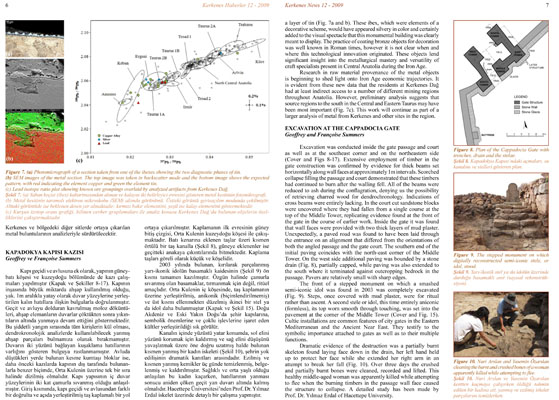| |
EXCAVATION AT THE CAPPADOCIA GATE
Geoffrey and Françoise Summers
Excavation was conducted inside the gate passage and court as well as at the southeast corner and on the northeastern side (Cover and Figs 8-17). Extensive employment of timber in the gate construction was confirmed by evidence for thick beams set horizontally along wall faces at approximately 1m intervals. Scorched collapse filling the passage and court demonstrated that these timbers had continued to burn after the walling fell. All of the beams were reduced to ash during the conflagration, denying us the possibility of retrieving charred wood for dendrochronology. Indications of cross beams were entirely lacking. In the court cut sandstone blocks were uncovered where they had fallen from a single course at the top of the Middle Tower, replicating evidence found at the front of the gate in the course of earlier work. Inside the gate it was found that wall faces were provided with two thick layers of mud plaster. Unexpectedly, a paved road was found to have been laid through the entrance on an alignment that differed from the orientations of both the angled passage and the gate court. The southern end of the initial paving coincides with the north-east corner of the Middle Tower. On the west side additional paving was bounded by a stone drain (Fig. 8), partially capped, while paving was also extended to the south where it terminated against outcropping bedrock in the passage. Pavers are relatively small with sharp edges.
The front of a stepped monument on which a smashed semi-iconic idol was found in 2003 was completely excavated (Fig. 9). Steps, once covered with mud plaster, were for ritual rather than ascent. A second stele or idol, this time entirely aniconic (formless), its top worn smooth through touching, was set into the pavement at the corner of the Middle Tower (Cover and Fig. 15). Cultic installations are common features of city gates in the Eastern Mediterranean and the Ancient Near East. They testify to the symbolic importance attached to gates as well as to their multiple functions.
Dramatic evidence of the destruction was a partially burnt skeleton found laying face down in the drain, her left hand held up to protect her face while she extended her right arm in an attempt to break her fall (Fig. 10). Over three days the crushed and partially burnt bones were cleaned, recorded and lifted. This healthy middle-aged woman was apparently killed while attempting to flee when the burning timbers in the passage wall face caused the structure to collapse. A detailed study has been made by Prof. Dr. Yılmaz Erdal of Hacettepe University.
|



